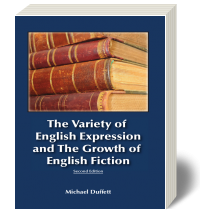

The Variety of English Expression and the Growth of English Fiction
Second Edition Duffett, © 2016, 210 pages
This textbook is suitable for an English literature course.
Request Examination CopyPrices and ISBNs
This title is available in the following formats.
|
Product
Description ISBN |
Description | ISBN | Bookstore (Net Price) |
Student (Retail Price) |
Excerpts
Description
Duffett's academic training at Cambridge occurred at a time (1960-1964) when English studies were dominated by such figures as F.R.Leavis and C.S.Lewis whose approaches differed widely. Leavis (to whom Duffett felt more drawn) stressed the value of practical criticism, close attention to what was on the page whereas Lewis' approach, first formed in Oxford from which university Lewis had migrated to Cambridge, was more grounded in scholarly consideration of such matters as literary trends and influences and biographical matters.
Duffett uses both approaches, attempting to define an era of literary taste, place an author within it and then look at particular examples of the work. The whole two books may be taught over a complete academic year or parts of it scheduled for a semester. The author is convinced that after a complete close reading of the book, the student will have a good grasp of the subject of English literature. There are omissions, probably due to the author's own predilections. There needs to be something on Milton; there is also a neglect of Shelley, the former because a separate complete volume needs to be devoted to the great blind poet and the latter due to the author's preference for others of the Romantics.
The books were written at an earlier stage of the author's academic career and could therefore benefit from treatment of more contemporary matters but Duffett's career has taken a more creative turn in recent years and he now writes more or less exclusively in verse.
Finally, a few words by way of apology to American readers: the book was written before the author was invited to teach in the United States and, whereas he is deeply impressed by American writers (Whitman and Emily Dickinson being favorites), the author has confined his critical attention to the two writers (T.S.Eliot and Henry James) who fit, by virtue not only of becoming British but of feeling great kinship, with English ways.
It will be clear that some passages seem to speak to students for whom English is not their first language but in our increasingly diverse society, that audience is growing.